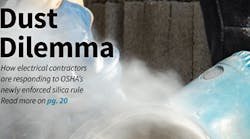Today's mobile office culture makes, adds, and changes necessary considerations in cable management design
Communications networks and control systems for today's offices require extensive cabling. For that reason, wire and cable management must be treated as an important design element. With the explosion of growth in a variety of communications services, customers and contractors are demanding greater capacity and easier placement methods. Moves, adds, and changes occur almost constantly, and as a result, manufacturers are introducing numerous cable support products to meet those demands.
Selecting the most appropriate pathway or support system for all of the cabling runs is the best way to prevent excessive mechanical stress on cables and thereby eliminate any possibility of performance degradation. At the same time, knowledge of general construction practices and local and national codes is also required.
Before making any selection, however, a designer/specifier should review the following factors:
-
Is it a new or existing facility? If it's old, what is its life expectancy?
-
How large and/or how complex is the network?
-
How much distributed control equipment is used?
-
How many cable runs extend to an individual workstation?
-
Are there plans for expansion, and when will they take place?
In addition to conduit, the overhead wireway/support systems include structural metal cable tray, ladder tray, wire basket cable tray, and runway hanging hardware. Floor delivery systems include cellular decking/trench cable systems, underfloor duct systems, raised-floor systems and poke-through devices. Perimeter systems center around surface raceway systems and flush-mount wall boxes. Work area/work surface systems include surface raceways and architectural columns for open space power and communications delivery.
When installing twisted-pair, coaxial, and fiber optic cable in conduit systems, pay particular attention to the coefficient of friction and pulling tension applied to the new cables. One way to achieve maximum usefulness of a conduit support system and provide flexibility for future changes is to partition the particular conduit before cable is installed by pulling multiple flexible innerducts into the conduit or purchasing a conduit system with integrated partitions. For example, a 4-inch conduit can contain three 1.25-inch innerducts. Cables can be run through a single partition, as the need arises, and pulling tension and friction is isolated to that partition.
Overhead hardware.
Overhead distribution systems are available in a variety of configurations for new construction or remodeling. These systems include wireway and cable tray, which are available in single-channel and divided designs with a range of sizes as well as cover and hanging options. While cable tray is relatively inexpensive and readily available, a contractor should consider the load rating, ease of assembly and installation, and the ability to expand when making a selection.
Solid-bottom cable trays can accommodate many cables and offer high load bearing capacity, which allows power and data lines to be separated by dividers. Solid-bottom trays can be specified with covers for maximum security, and ventilated louvers can be ordered to prevent accumulation of moisture. A solid-bottom cable tray can be hung with a central rod support, a C-hanger, or in a two-hanger trapeze arrangement. Cable tray systems incorporate dropout fittings, which provide a smooth transition from the plenum-space tray down to the office work area without excess bending or cable stress.
A cable tray with a hinged or screw-on cover, which offers complete protection for the cabling, is called a wireway.
A center spine cable tray has a central support member with rungs extending on both sides. An adjustable center-spine can be bent to get around obstacles in both horizontal and vertical planes. Rods spaced along the central support member provide the hanging method. A variation on the center spine tray is the wall-mounted cable tray.
Ladder-style tray is commonly used when it's necessary to span anywhere from 12 feet to 30 feet. A specific version of the ladder style tray is the cable runway system, available in 6-inch, 12-inch, 18-inch and 24-inch widths and a variety of lengths, with either a tubular or a solid cross section. This product is especially useful when confronting installation challenges in a telecommunications closet with high-density cabling.
Another style of tray particularly noted for flexibility is the wire mesh, or wire basket tray, which is usually made of welded steel and available for 1-inch, 2-inch, or 4-inch cable fills and in 2-inch to 24-inch widths. Wire basket is available in zinc-plated or painted finishes, and its main advantage is the fact that you can design and fabricate the system in the field. It's possible to assemble it with a few hardware pieces, such as connectors, fasteners, and hangers. Metal covers and pan liners are also available.
The NEMA VE-1 standard for metal cable tray systems recognizes traditional two-side rail, single-rail, and wire mesh classifications of cable tray. One manufacturer extends its wire basket/wire mesh systems beyond the definition of cable tray outlined by the NEC, since the metal assemblies can be field bent without tools. The tray sections are joined by a single CB-10 universal connector bolt, creating a mechanical and electrical bond between the sections.
Many cable tray and wire mesh cable tray products are also set directly on the structural floor beneath access floor systems. They're available with special accessory hardware items for these applications.
Proper grounding is important on a metal cable tray system, even though it contains only data communications wiring. It must be able to safely carry fault current or an accidental electrical discharge like lightning.
Office facilities are more frequently installing “fiber to the desk,” and several manufacturers have cable trough systems that consist of conduits, elbows, bends, downspouts, tees, and crosses designed to support optical fiber cable runs. Usually these systems are brightly colored plastic and clearly labeled to distinguish them from copper cabling runs. Modular systems use short link segments and make it easy to pass cable around obstructions and through tight spaces — especially in telecommunications closets — to protect them from being snagged or crushed.
When choosing a plastic cable management system, you should consider several factors, including maintaining a minimum bend radius. Some troughs have slotted sides that allow cable drops without special hardware. For plenum spaces, plastic components should be made from PVC with a UL-94VO flammability rating.
A plastic cable trough/tray system can't support as much weight as one made from metal, and a metal system may also be best for applications in harsh environments and in locations subject to abuse. Another place where metal may be required is in passing through fire-stops and fire walls.
Floor-based hardware.
Cellular floor and underfloor duct distribution systems must be designed as part of the office building structure. Cellular floor consists of structural steel decking, which is an integral part of composite floor slab in steel frame construction. A metal channel, called a trench header, connects the individual cells and is installed flush with the finished floor slab. The degree of flexibility with cellular floor depends on the module spacing of the presets and cells. Because the preset inserts are easy to activate and de-activate, cellular decking offers some of the lowest relocation costs.
Underfloor duct may be used in either steel or concrete structures, but the concrete floor slab must be thicker than what a cellular floor requires. Underfloor duct systems are available with flush service fittings that fit over single-, double-, or triple-duct runs. This cable distribution method is quite expensive to install and relocation expenses are very high.
Access floor, also called raised floor, consists of metal panels supported on pedestals 4 inches to 12 inches above the structural floor. The panels, usually 2 feet by 2 feet, can be removed to achieve convenient access to the floor plenum. Panels are covered with carpet squares or tile. Outlets, which are usually flush with the floor, are installed in pre-selected panel cutouts. Both power and communications circuits can be carried in pre-manufactured flexible plug-in cables.
After becoming popular in Europe and Japan, thin raised floors are beginning to gain popularity in the United States as well, because they provide many of the benefits of a full raised access floor but at much lower costs. The system is only a few inches tall and supports standard flush faceplates. This surface-mount, raised floor raceway system offers a number of advantages, such as reusability and portability. It's available in plastic and metal construction.
Cellular floor, underfloor duct, access floor, and thin raised floor all use recessed boxes and flush receptacle outlets. In all cases, these outlet boxes must have covers that meet the scrub water exclusion test on carpet and wood floors that was recently mandated by UL. This requirement ensures that water doesn't enter the power or communications housing when the device is exposed to, or in the vicinity of, cleaning equipment.
Workspace hardware.
Also known as perimeter system hardware, surface mounted raceway — especially multi-channel units — offers flexibility for routing data, voice, video, and power wiring since outlets can be placed anywhere along the raceway. These products are available in steel, aluminum, and plastic. Plastic products can be specified in a host of colors, with trim moldings and wood veneers. A latching raceway feature simplifies cable placement and removal. Safety interlock systems on the covers offers additional saving on specific applications.
Cove molding raceway combines the convenient features of a surface wiring installation within the building surfaces, usually running at the ceiling line.
Architectural columns carry power and communications cabling from plenum spaces to desktop locations; modular furniture feeds are available at the ground level. Products are compatible with a wide range of standard power and communications devices.
The options for communications wiring components and the resultant permutations are many, so it's a good idea to remain current on what's out there. And with as important as cable management has become in office building design in recent years, you'll want to try to avoid making more moves, adds, and changes than necessary.


